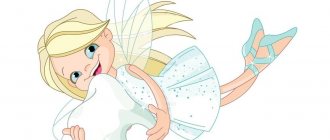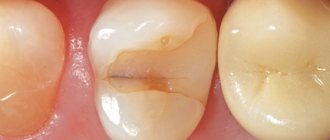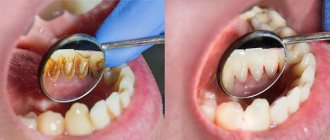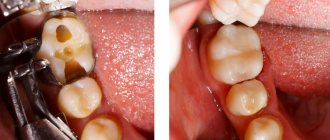Toothache has different manifestations and causes. Carious destruction of enamel, trauma, damage to the mucous membrane, gum disease and even the eruption of permanent units can provoke discomfort, cause fever and general ill health. While waiting for an appointment with a doctor and an accurate diagnosis, parents should be able to conduct an independent diagnosis - calm the baby and provide first aid. To do this, it’s worth figuring out why and what to do if a child at 3-4 years old has a toothache.
Can a child’s baby teeth hurt: dental problems in children
Parents often ask: can baby teeth hurt in a 2-5 year old child? The answer from dentists in this case is always positive. Baby teeth are also susceptible to caries, just like permanent teeth. Moreover, superficial caries can quickly develop into deep caries - causing pulpitis and periodontitis.
Although caries is the main answer to the question “can baby teeth hurt in a 4-year-old child,” there are other dental diseases that provoke complaints in a child. Among them:
- enamel erosion;
- dental hypersensitivity;
- mechanical tooth trauma;
- stomatitis;
- gingivitis;
- periodontitis.
Gum diseases and mucosal ulcers are also included in this list, since a 3-5 year old child will say that his teeth hurt, and will not indicate the true problem.
To help parents: home diagnostics based on the nature of pain and indirect symptoms
Children often complain of toothache, including any discomfort in the oral cavity in this category. The task of parents is to understand what worries the child. A small cheat sheet on dental diseases will be an assistant in diagnosis:
- Caries. At the initial stage, it is noticeable in the form of white matte spots, which gradually darken to brown or black with the formation of holes. Pain manifests itself when there is pressure on a tooth, when pieces of food enter the carious cavity, or as a reaction to cold or hot.
- Pulpitis. It is not always accompanied by severe pain, although with significant nerve damage, the disease causes severe anxiety in the child. External signs are swelling of the soft tissues around the diseased unit, a change in the shade of the tooth.
- Periodontitis is the next stage of the disease with advanced pulpitis. A lump forms on the gum. The pain is sharp, especially when touching a tooth.
- A fistula is a small bubble on the gum, usually under a filled tooth. A symptom that pus has accumulated in the inflamed area and requires release. The pain is temporary and not permanent. Without treatment, there is a high probability of damage to the rudiments of the radical units, so a visit to the dentist is a necessity.
- Flux is an inflammatory process of the periosteum, accompanied by swelling on one side of the face and severe pain in the tooth. A sharp rise in temperature is possible.
- Enamel erosion is a non-carious darkening of the tooth surface that occurs as a result of poor hygiene or an unbalanced diet. Pain occurs as a response to irritating factors - hot food, cold drinks.
- Stomatitis is painful sores, white plaque or pimples in the mouth. In advanced cases, there is general malaise and fever in the child.
- Gingivitis and periodontitis are inflammation of the gums with severe swelling and redness. The pathological process is accompanied by pain and tooth mobility.
- Teething can be painful, both in very young children and in school-age children when molars appear. Signs of the eruption of baby and permanent molars are swollen gums, increased salivation, poor sleep, temperature fluctuations.
Rodikova Tatyana
Parents do not believe that teething in schoolchildren can be very painful. Especially if the first teeth grew easily and imperceptibly. I would like to note that molars can take a long time to erupt - with fever, swelling and refusal to eat. If your child experiences these symptoms, it is worth making an appointment. The doctor will accurately assess the baby’s condition and suggest how to facilitate the growth of new teeth.
Causes
Before giving painkillers to children, you need to understand what caused the disease. This may include:
- Anatomical features in the structure of the ear. The auditory tube in children is much shorter than in adults and is located quite close to the nasal cavity. When any infection enters the nose, it can instantly affect the child’s ear.
- Genetic predisposition. Experts say that if parents often suffered from otitis media in childhood, then the same thing will happen to the child.
- Constant colds. Children under seven years of age very often suffer from ARVI and influenza. Otitis media can act as a complication and occur against the background of rhinovirus, adenovirus and rotavirus infections.
- Bacterial infection. There are three bacteria known in medical practice that can cause ear pain. These include streptococcus, Haemophilus influenzae and Moraxella. If your ear hurts as a result of a bacterial infection, then the uncomfortable feeling appears suddenly. At the same time, the baby does not have a cough or runny nose. Temperatures can rise to 39 degrees. Also, pus with an unpleasant odor is released from the ear canal.
- Tendency to allergic reactions. If children often suffer from allergic manifestations, then due to swelling of the nasal cavity, compression of the ear tissue occurs. It also prevents fluid from draining from the auditory tube.
Baby tooth hurts after treatment
Pain in a baby tooth after treatment is also not uncommon. And here parents should carefully monitor the baby to understand the cause of the complaints:
- Poor quality treatment. The doctor did not clean the root canals well and did not place a sealed filling. There is only one solution - make an urgent appointment with the dentist and repeat treatment with a good dentist.
- Residual discomfort. This happens when the treatment is complex and soft tissues are injured during drilling or dental procedures. Adults should think about how to relieve a child’s toothache at home - give a painkiller or rinse. If you have long-term complaints, you should make an appointment with a doctor for a consultation and re-examination.
- Allergic reaction to materials and drugs. Allergies most often manifest themselves as itching, but can also cause pain. If the cause of the reaction is an anesthetic used by dentists, it is worth giving a suitable antihistamine. In other cases, you cannot do without visiting a doctor.
Marina Dolotova
You can find cheap dental clinics in Moscow, but it is always worth assessing the health risks. Children with poorly placed fillings are increasingly being brought to Azabuka. And, what’s worse, with prolonged inflammatory processes. Kids cry and complain. I treat teeth and reassure both patients and parents. Such practices are very sad.
A child’s baby tooth hurts and is loose: treat or remove
Sometimes a child's front baby tooth hurts and becomes loose. Increased mobility can be caused by a planned change of bite or injury. A child’s front teeth hurt after an unsuccessful fall, a blow in the sports section, or minor bicycle accidents. A doctor will be able to remove the consequences of mechanical impact after an x-ray and examination of the oral cavity.
If a permanent tooth is cut under a temporary tooth, and this causes pain, the doctor, of course, will recommend removal. But this is the only option when removal is preferable. In all other cases, teeth with primary temporary occlusion should be protected - fillings should be placed, caries and pulpitis treated, and gum inflammation relieved. It is not worth getting rid of a diseased tooth in the hope of a permanent bite - with early removal, pathological changes in the primary and permanent units and serious orthodontic problems in the future are possible.
A child’s baby tooth hurts: what to do at home
How to help a child with a toothache is the main question when waiting to see a dentist. There are several options:
- folk remedies;
- medication assistance;
- massage.
Traditional methods of relieving toothache
If a child’s baby tooth hurts, folk recipes will tell you how to relieve the pain. There are many of them, but you should choose only herbs and tinctures, the use of which is acceptable for the specific age of the baby. Rinsing will help cope with painful teething and relieve discomfort after filling:
- Warm decoction of sage, chamomile or lemon balm.
- Propolis tincture, slightly diluted with water.
- Oak bark brewed for rinsing.
- Soda solution.
Painkillers
When a 5-year-old child has a toothache, there are usually no questions about what to do. The first thing parents remember is medications that can alleviate the baby’s condition before seeing a doctor. The most popular means:
- gels and ointments - with a cooling, anti-inflammatory, antibacterial and analgesic effect;
- syrups and tablets are medicines in which the active ingredient is paracetamol or ibuprofen.
An alternative solution would be homeopathic preparations - drops, suppositories and ointments based on plant substances.
Massage to relieve toothache in a child
What to do if a child has a toothache, and medications and homeopathy do not help. You can use the secrets of oriental medicine and try acupuncture massage:
- Fingers - you need to massage the index and middle fingers on the hand opposite to the diseased tooth. At least 7 minutes. The second option is to stroke and lightly press the area between the index and thumb on the side of the diseased tooth for about 5 minutes in a circular motion.
- Ears – you need to massage the upper part of the ear in a circular, soft motion. Within 5-7 minutes.
- Jaws - smooth circular movements with your fingers at the base of the disturbing jaw will help relieve pain.
Methods for reducing pain
Seeing a child suffer is a real test for any parent. That is why they strive to eliminate unpleasant symptoms at home as soon as possible. A mild analgesic, for example, in the form of syrup or tablets, is suitable for these purposes. However, it is not recommended to act on your own; it is best to first consult with your dentist.
If it is not possible to show your child to a doctor now, you can purchase a gel or ointment containing an anesthetic at the pharmacy. They will help to temporarily relieve pain, as a result of which the baby will be able to fall asleep and wait for a visit to the clinic. One option is a children's drug called Dentinox. Its formula contains lidocaine, as well as natural chamomile extract.
Another option is the use of homeopathic medicines. Natural-based products will help slightly reduce the discomfort, but they are unlikely to completely remove the pain. If a high temperature appears, this may indicate that inflammation has begun. It is also acceptable to take antihistamines, especially if swelling and itching occur. Popular children's drugs: Parlazin and Fenistil. It is important to remember that it is best to start taking any medications only after examination and consultation with a doctor.
previous post
My child has a toothache after silvering, what should I do?
next entry
What not to do if a child’s baby tooth hurts
When the question is how to relieve toothache in a child 3 years old or older, several actions are strictly prohibited. Among them:
- warming - do not heat a sore tooth;
- cooling - cold relieves pain, but the facial nerve can get cold;
- compresses – active substances in compresses often provoke allergic reactions and chemical burns to the baby’s delicate skin;
- strong painkillers - adult medications are contraindicated for children even with the most severe toothache;
- feed the child spicy foods - as well as very cold or hot ones, since aggressive exposure increases the pain.
What is the reason?
It is generally accepted that the cause of pain is caries. In fact, there are many more sources of pain. Therefore, when a child has a toothache, it is important to understand what caused it:
- pulpitis, periodontitis – inflammation of internal tissues;
- flux - inflammation of the periosteum;
- gingivitis – inflammation of the gums;
- abscess – accumulation of pus in the tissues surrounding the tooth;
- enamel erosion;
- ulcer on the mucous membrane;
- fistulas;
- caries.
With caries, the pain is usually paroxysmal, does not last long - up to several minutes, and occurs when eating cold or hot food. In case of pulpitis, periodontitis - acute, lasts for hours, is not relieved by painkillers, therefore the child needs help immediately.










